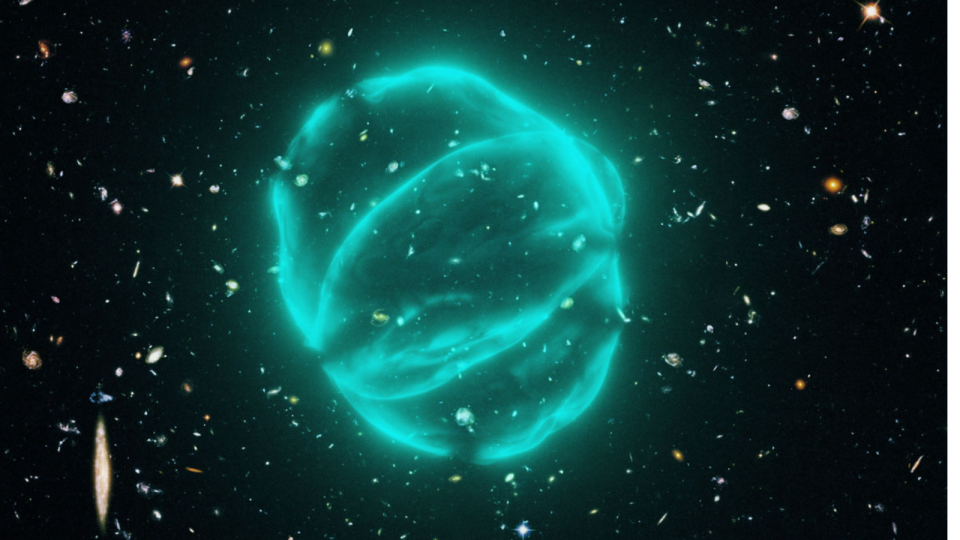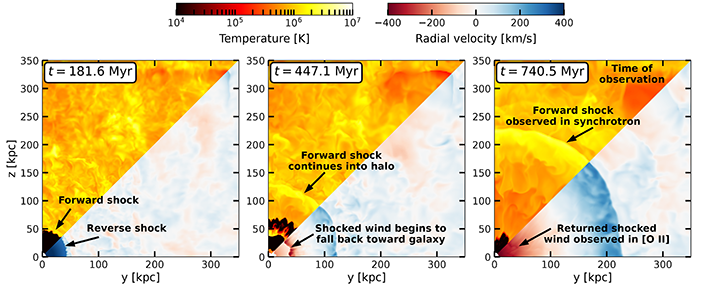Scientists may have finally solved the mystery of cosmic ORCs, or “strange radio circles,” as they are officially known, which are so vast they measure 10 times the width of the Milky Way and can span entire galaxies.
A team of astronomers led by UC San Diego Professor of Astronomy and Astrophysics Alison Coil has pointed out that powerful winds arising from bursts of exploding stars, or supernovae, are the cause of the vast layers of gas seen in radio waves as ORC. The research was released Wednesday (Jan. 8) at the 243rd meeting of the American Astronomical Society in New Orleans.
ORCs were first detected by the Australian Square Kilometer Array Pathfinder (ASKAP) in 2019 and represented something truly puzzling that astronomers had never seen before.
Coil and his team used the WM Keck Observatory’s integral field spectrograph on the dormant Maunakea volcano on the island of Hawaii to observe the ORC 4 radio circle, finding highly compressed gas and stars approximately 6 billion years old inside. of years. This suggested to the team that these radio circles could be created when several stars explode almost simultaneously in the same galaxy.
Related: Cosmic orcs? Scientists take best image yet of mysterious ‘strange radio circles’ in space
Do cosmic ORCs tell a story of stars from cradle to grave?
When massive stars reach the end of their lives and explode in supernova explosions, large amounts of stellar material are ejected in powerful winds into the surrounding galaxy.
Coil and his colleagues believe that if enough supernovae occur in the same region of space at about the same time, these winds can reach speeds of up to 4.5 million miles per hour, about 5,000 times faster than a bullet fired from a gun.
The question is: what kind of galaxies would host so many stars exploding at approximately the same time?

This could happen in galaxies that have experienced episodes of intense star formation, which astronomers call “starburst” galaxies.
“These galaxies are really interesting,” Coil said in a statement. “They occur when two large galaxies collide. “The merger pushes all the gas into a very small region, causing an intense burst of star formation.”
Massive stars formed in a merger-triggered episode of rapid star formation burn their nuclear fusion fuel at the same rate, exploding in supernova explosions and expelling gas as winds at similar times.


As these winds exit these star-forming galaxies, they collide with slower-moving gas around the galaxy. This interaction creates a shock wave that generates ORCs, which can extend for hundreds of thousands of light years. To put this in context, the Milky Way is about 98,000 light years wide and a light year is the distance light travels in one year, approximately 6 trillion miles (9.7 trillion kilometers).
Solving the mystery of cosmic ORCs
Prior to the development of this supernova wind theory driven by starburst galaxies, scientists had suggested several other creation mechanisms to explain ORCs. These included the merger of two black holes and the creation of planetary nebulae during supernova explosions that mark the end of a star’s life.
The problem was that ORCs had only been seen in radio waves and this data was not enough to distinguish between possible creation models.
Suspecting that the ORCs could be the result of later stages of starburst galaxies they had been investigating, Coil and his team began studying ORC 4, the first example of these radio deposits discovered to be visible from the Northern Hemisphere, with the integral field. spectrograph at the WM Keck Observatory. This revealed a huge amount of bright, highly compressed gas.
Continuing their detective work and using radio wave data and optical light observations, the team discovered that the stars within ORC 4 were around 6 billion years old, implying that a burst of intense formation had occurred. star at the heart of this radio circle that ended about a billion years ago.
The team then turned to a computer simulation developed by research co-author and galactic wind specialist at the Harvard and Smithsonian Center for Astrophysics, Cassandra Lochhaas, to advance their research.
The simulation allowed the team to observe the development of ORC 4 over 750 million years, just short of its estimated billion-year existence.
Replicating the size and properties of ORC 4 and taking into account the enormous amount of gas impacted in the galaxy at its heart, the simulation showed galactic winds flowing outward over a period of around 200 million years.
Even when these winds stopped, the shock wave they launched continued to move forward, expelling hot gas from the galaxy, creating the surrounding radio ring, and also causing the cooled gas to fall back into the galaxy.
“For this to work you need a high mass egress rate, which means a large amount of material is ejected very quickly. And the surrounding gas just outside the galaxy has to be low density, otherwise the crash stops. These are the two key factors,” Coil said. “It turns out that the galaxies we’ve been studying have these high mass outflow rates.
“They’re rare, but they exist. I really think this points to ORCs originating from some kind of outward-flowing galactic wind.”
Related stories
—What are radio galaxies?
—An unprecedented radio burst could help us find the missing matter in the universe
—Light from the cosmic network that connects galaxies has been seen for the first time (video)
The revelation that ORCs like ORC 4 are likely the result of outgoing galactic winds means that these radio circles can be used as surrogates to study these powerful winds and answer important questions about galactic evolution.
“ORCs provide us with a way to ‘see’ the winds through radio and spectroscopy data. This can help us determine how common these extreme galactic winds are and what the life cycle of the wind is,” Coil said. “They can also help us learn more about galactic evolution: do all massive galaxies go through an ORC phase? Do spiral galaxies become elliptical when they are no longer forming stars?
“I think there is a lot we can learn about ORCs and learn from ORCs.”
In addition to being presented at the American Astronomical Society meeting in New Orleans, the team’s research is also detailed in the Jan. 8 issue of the journal Nature.